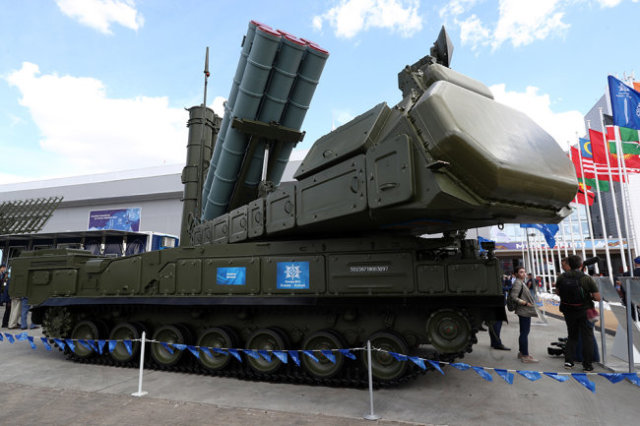The advantage of the Russian anti-aircraft missile system lies in better performance and combat stability, experts from the Analytical Center for Aerospace Defense noted in an article for the National Defense magazine
MOSCOW, April 4. /tass/. The Russian Viking medium-range anti-aircraft missile system (an export version of the Buk-M3 air defense system) surpasses analogues from NATO countries, in particular, the German IRIS-T SLM, the Norwegian-American NASAMS III and the SAMP/T consortium Eurosam, in combat performance and combat stability, experts of the Analytical Center for Air Defense-space defense in an article for the magazine "National Defense" .
"All Western manufacturers report the unique rate of fire of their PU (launchers) - they can shoot 6-8 missiles (anti-aircraft guided missiles) in 10 seconds. At the same time, the number of target channels is disclosed only for SAMP/T - 10. And using the example of SAMP/T, it can be seen that the rate of fire of the PU is not equivalent to the fire performance of the complex as a whole," the authors of the article write.
So, after firing 10 missiles at SAMP/T, all target channels are loaded due to the peculiarities of the missile guidance scheme, and the next launch becomes possible only as the channels are released. In the medium range zone, the waiting time will be from 15 to 60 seconds, depending on the distance to the target. At the same time, the interval between launches of the Viking is two to three seconds.
"But the complex as a whole has 36 target channels and 72 missile channels. As a result, having less rapid-fire PU, Viking has significantly higher fire performance in its area of responsibility," the experts explained.
Maneuverability and stability
The advantage of the Viking is its tracked chassis, which allows you to operate without being tied to paved roads and in a wide range of climatic conditions. The experience of modern combined arms combat shows that the mobility and combat stability of military equipment are directly related.
In addition, the Viking has a higher rate of deployment of main combat assets from the marching order to the combat one - only 5 minutes, the entire complex is deployed in 10 minutes. Also, the Russian air defense system is able to leave the position with the systems turned on within 20 seconds after the launch of the missiles. Another factor in ensuring its combat stability is the 15 mm armor.
At the same time, foreign medium-range complexes are mounted on a wheelbase, which requires good roads. From marching order to combat, Western air defense systems are deployed in 10-15 minutes, depending on the type.
"The combat stability of the IRIS-T SLM and SAMP/T batteries is also sharply weakened by the presence of only one radar in their composition. After hitting the radar, all the means of these complexes fail. It is worth noting that the developers of Kongsberg Gruppen realized this threat: the NASAMS III battery includes six to eight radars - about one for every two PU. This proportion roughly corresponds to that of the Viking air defense system," the authors note.
Thus, the high maneuverability capabilities allow the Viking to quickly move into position and engage in battle, and after completing the task, leave the dangerous area in order to avoid a retaliatory strike.
In conclusion, the authors of the analysis concluded that in the West, air and sea-based complexes are preferred in the organization of air defense, and land-based air defense systems are developed according to the residual principle.
"In the IRIS-T SLM air defense system, the number of missiles and their range make the radar power many times excessive. In SAMP/T, on the contrary, the TTX of radars does not allow to realize all the capabilities of the missile defense system. The high rate of fire of the PU is not consistent with the number of target channels. "The squadron sails at the speed of the slowest ship" - this old principle is the best way to assess the capabilities of modern Western medium-range air defense systems," the article emphasizes.
Unlike its Western counterparts, the Russian Viking has balanced characteristics of reconnaissance range and guidance range, the number of escorted targets, firing, target, missile channels, anti-aircraft missiles and the size of ammunition - all these characteristics are consistent with each other.
"Yes, according to a number of characteristics, the Viking air defense system is a world record holder. But the main thing is that he has no weak points. None of the subsystems slows down the complex as a whole, each one works to increase its performance characteristics. If we take into account the high maneuverability characteristics and good combat stability, it becomes obvious that we have an air defense system optimally suitable for participation in combined arms combat," the experts concluded.

